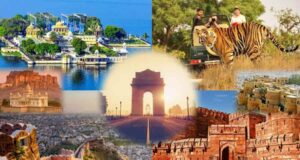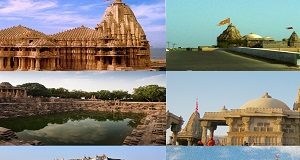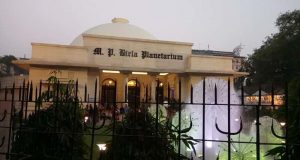Mahabaleshwar – The Land Of God Of Great Power
Mahabaleshwar is a hill station, tourist destination, and pilgrimage spot in the Western Ghats in the Satara district of Maharashtra state, India. Being a vast plateau, it is enclosed by valleys and is one of the rare evergreen forests in the world. The meaning of the name of this resort is Great (Maha) and Power (Bali). It covers three villages namely, the Malcolm Peth, Old “Kshetra” Mahabaleshwar, and a part of the Shinola village.

The spiritual legendary shrines, eye-catching scenic points, the continuing springs, snaky streams, and high waterfalls accompanied by a pleasant climate, and tasty strawberries, honey, and mulberries are the memorable attractions of Mahabaleshwar.
It is at this place that holds the source of the Krishna River those routes through Maharashtra, Karnataka, and Andhra Pradesh to meet the Bay of Bengal. This renowned source is a spurt from the cow’s mouth carved in the old temple of Mahadev (Lord Shiva) in old Mahabaleshwar. A mysterious scene of the Krishna River is that its four tributaries also emerge from the cow’s mouth and they too flow some distance prior to merging into it. These tributaries are the Koyna, Veena (Veni), Savitri, and Gayatri. According to a legend, due to the curse on the three Hindu gods (known as Trimurti) by Savitri (a sacred legendary woman), Krishna is Lord Vishnu himself, Venna is Lord Shiva, and Koyna is Lord Brahma.
History
1215:
Mahabaleshwar came into the picture when the King Singhan of Deogiri approached the old Mahabaleshwar. He actually erected a small temple and water lake near the carved cow’s mouth.
1350:
A Brahmin dynasty ruled over this area.
Mid 16th Century:
The Maratha people of Chandarao More fought with the Brahmin rulers and were successful in invading Jaoli and Mahabaleshwar. It was in this period that the old Mahabaleshwar shrine was reconstructed.
17th Century:
Shivaji ruled over Jaoli and Mahabaleshwar.
1819:
The British ruled over it by considering it as the part of Satara British Kingdom.
1829-30:
The modification made to the resort is what we see today.
According to the British records, Mahabaleshwar was known as Malcolm Peth and was the summer capital of Bombay in their rule.
Tourists’ Attractions
Mount Malcolm:

This is the most popular structure of olden times built-in 1829. It is an architectural marvel and a building worth seeing.
Catholic Church:
This is an old Roman Catholic Holy Cross church looked after by a Hindu family. Being in an isolated area, the stained glass window of the church still attracts both native and foreign people.
Mahabaleshwar Club:
Erected in 1881, it comprises eye-catching roses and a jogging track. However, only the club members can reside here. For the visitors, only the golf- the course is open. This is the club is worth visiting during Christmas due to the royal grand celebration.
Morarji Castle:
This is a worth visiting old structure where Mahatma Gandhi once resided in 1945.
Pratapgad Fort:

Built-in 1656 by Moropant Trimak Pingle under the instructions of the great Maratha ruler, Shivaji; it is 24 km away from Mahabaleshwar with a great magnificent view. At this fort, Shivaji killed the powerful general of Bijapur, Afzal Khan.
Raj Bhavan:
This is the summer residence of the Governor of Maharashtra.
Lodwick Point:
This is the point named behind Late General Sir Peter Lodwick who in April 1824 climbed the mountain face until this point with the help of Indian guides.
Elphinstone Point:

This is a small spot ignoring the Koyna river valley.
Dhobi Falls:
This is between the above two points.
Arthur’s Seat:
This is at 1,348 m above sea level ignoring the attractive Jor Valley.
Tiger’s spring:
This is just 1 km away from Arthur’s Seat and by going ahead; do not miss ‘The Window’ view.
Krishna and Mahabaleshwar Temples:

These shrines hold spiritual significance for Hindus who believe in Lord Krishna and Lord Shiva. There is one more temple carved out of black stone and has a lovely view.
Point of Five Rivers:
This is the point from where you can see the Krishna, Koyna, Savitri, Veena, and Gayatri flowing over the plateau.
Kate’s Point:
This is at 1290 m along Duchess Road.
Panchgani:

This is 20 km from Mahabaleshwar famous for its tableland long plateau.
Lingmala Waterfall:
This is above the famous Venna Valley located 6 km from the post office. The waters cascade down from a height of 600 feet.
Wilson Point:
This is the highest point on the hill at 1,435 m ahead of the above waterfalls.
Helen’s Point:

This is the southeast of the Wislon’s Point in the Blue Valley.
Badington Point:
This is another scenic ignoring the Koyna Valley.
Chinaman’s fall:
This is ahead of the above point followed by the Falkland Point, Carnac Point, and the Bombay Point.
Veena Lake:

Enclosed by trees, an evening boat ride amidst the fog and a horse ride around the lake are its attractions. You can also enjoy the eatables along the banks of the lake.
Market and the S.T. Bus Stand:
This facilitates a nice walk and is about 2 km away from the lake.
Reaching Mahabaleshwar
By air, the nearest airport is Pune at 120 km. By rail, Pune is also the preferable station.
By road, from Mumbai, it is 290 km (5 hours), half an hour from Panchgani, and from Pune, it is 120 km away.


